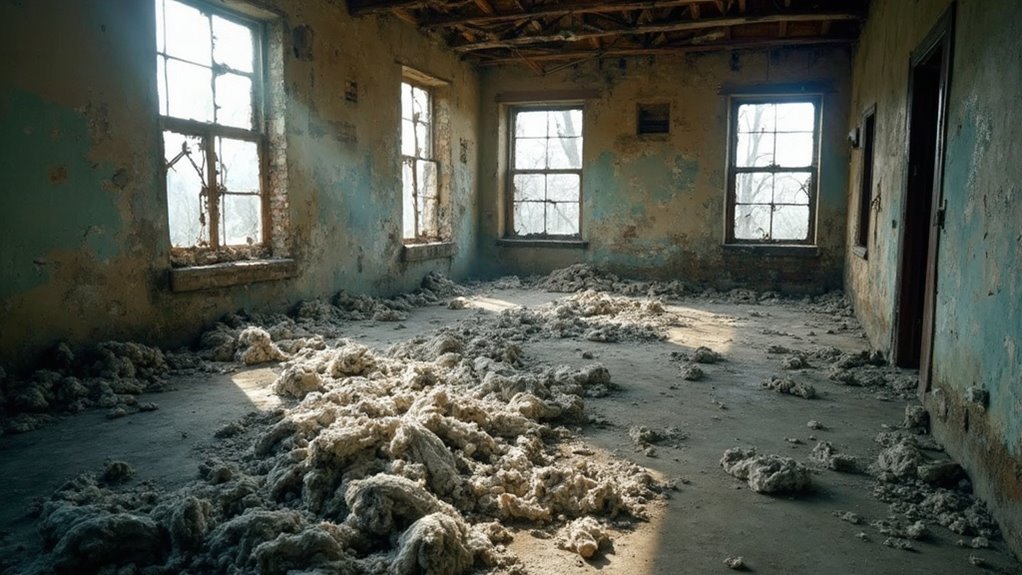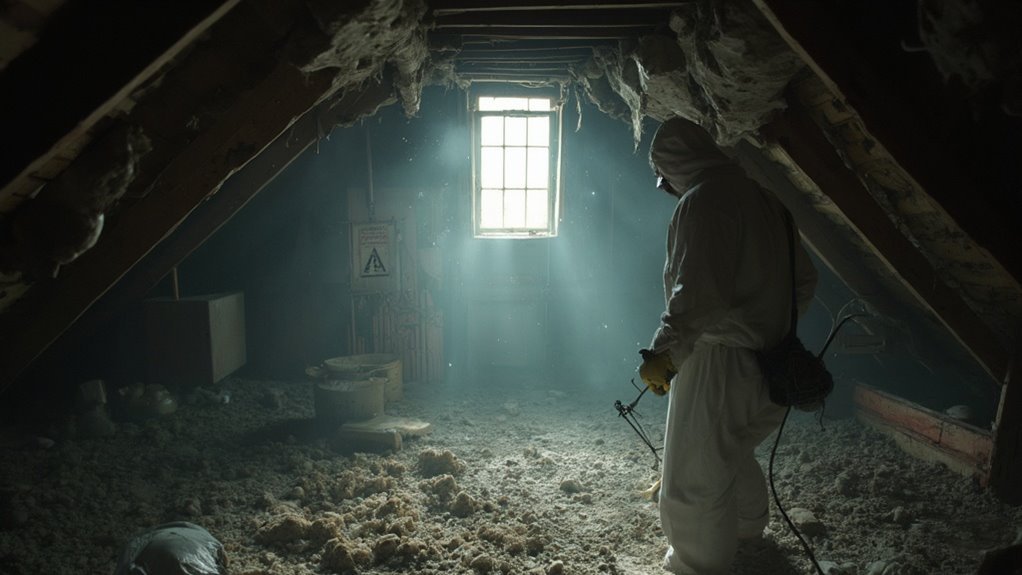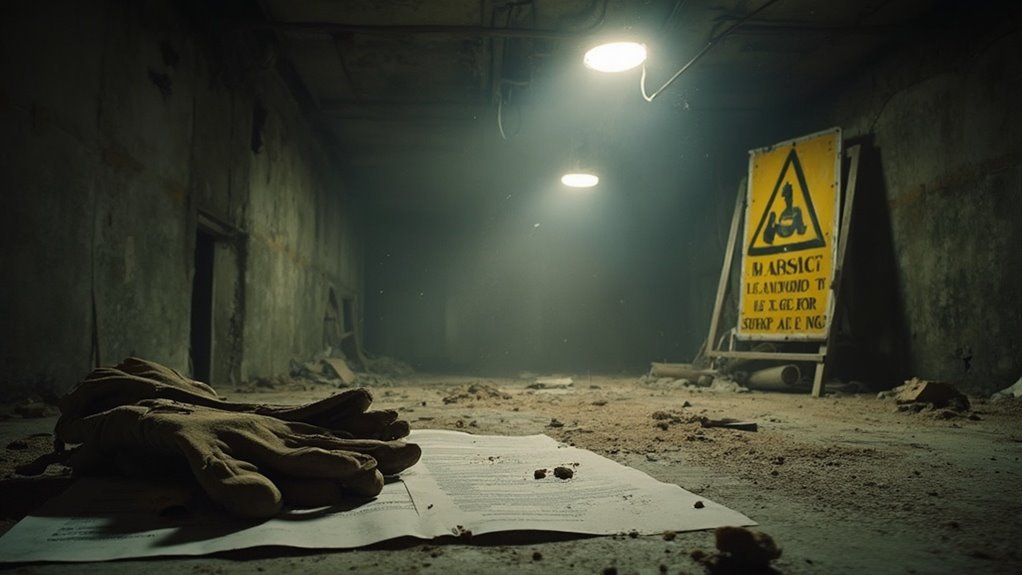Your property is at risk if it contains asbestos, as exposure can lead to serious health issues like lung cancer and mesothelioma. Skipping asbestos abatement isn't an option; inadequate handling can result in legal liabilities and decreased property value. Certified professionals must assess and manage any asbestos-containing materials (ACMs) to verify compliance with regulations, protecting both your health and finances. Engaging experts assures that proper containment and removal procedures are followed, reducing airborne fibers and contamination. Understanding these risks is crucial for safeguarding your property and future investments. Uncover the critical steps you should take for effective management.
Understanding Asbestos Risks

Understanding the risks associated with asbestos is fundamental for maintaining health and safety in various environments. Asbestos is a naturally occurring mineral known for its heat resistance and strength, properties that historically made it popular in construction and manufacturing. Nevertheless, these same properties pose significant risks when asbestos-containing materials (ACM) are disturbed.
To effectively manage these risks, you need to understand the sources of potential exposure, such as construction activities, vehicle maintenance, and even residential properties with contaminated insulation. Detection methods play a key role in identifying ACM. Regular inspections using specialized tools can help locate and assess the condition of asbestos materials, enabling timely intervention. Engaging certified professionals for asbestos testing and removal is critical to ensuring safety and compliance.
Moreover, since asbestos fibers can remain airborne for extended periods, they can contaminate large areas, leading to widespread environmental concerns. Awareness of the environmental impact, including air, soil, and water contamination, is crucial for effective risk management. Remember, strict regulations exist to guide safe handling and removal of asbestos. Approximately 10,000 deaths per year in the U.S. are linked to asbestos exposure, highlighting the urgent need for proactive measures. By staying informed about asbestos properties and employing proper detection methods, you can take proactive steps to protect yourself and others from potential exposure.
Health Hazards of Asbestos
As you consider the health hazards of asbestos, it's vital to recognize that exposure can lead to severe diseases, including lung cancer and mesothelioma. These asbestos-related conditions often develop silently over decades, with symptoms appearing long after initial exposure. Understanding the risk factors associated with asbestos can help you take necessary precautions to protect your health. Moreover, even minor exposure carries significant health risks, necessitating close monitoring to detect any potential issues early on.
Asbestos-Related Diseases Overview
Exposure to asbestos poses substantial health risks, leading to a range of diseases that can severely impact quality of life. Asbestos exposure is primarily linked to several cancer types, including mesothelioma, lung cancer, and cancers of the larynx and ovary. While evidence is limited, some studies suggest connections to stomach, pharynx, and colorectal cancers. Additionally, nonmalignant disorders such as asbestosis, pleural plaques, and pleural thickening arise from exposure.
The latency period for these diseases is concerning; symptoms may not manifest until 15 to 50 years after initial exposure. Common symptoms include shortness of breath, wheezing, and a persistent cough that worsens over time. Importantly, co-exposure to tobacco smoke greatly increases lung cancer risk.
Globally, asbestos-related diseases result in over 200,000 deaths annually, underscoring their serious impact. Mesothelioma, particularly sensitive to even minimal exposure, can develop decades later, complicating diagnosis and treatment. Understanding these health hazards is vital, as recognizing the risks associated with asbestos exposure can guide effective preventive measures and timely interventions.
Exposure Risk Factors
Throughout your life, various factors can influence the risk of developing health issues related to asbestos exposure. Understanding these exposure risk factors is crucial for protecting your health.
| Factor Type | Risk Description |
|---|---|
| Duration of Exposure | Prolonged exposure increases lung cancer risk. |
| Asbestos Sources | Occupational and environmental exposure are significant. |
| Types of Fibers | Amphibole fibers are more harmful than chrysotile. |
| Individual Vulnerabilities | Smoking and pre-existing lung diseases heighten risks. |
The duration and dose of exposure are important; significant and prolonged exposure raises the risk of diseases like lung cancer and mesothelioma. Even low levels can pose health risks over time. Individual vulnerabilities, such as smoking or genetic factors, further worsen these risks. For instance, if you smoke and have been exposed to asbestos, your chances of developing lung cancer multiply. Moreover, living near asbestos mines can increase your risk, even without direct occupational exposure. Awareness of these risk factors is crucial for effective asbestos abatement and ensuring your long-term health.
Importance of Professional Abatement

When dealing with asbestos, relying on professional abatement services is essential for ensuring safety and compliance. These experts possess the necessary certification and training to adhere to regulations, minimizing legal risks and health hazards. By employing thorough abatement procedures, you protect not only your property but likewise the well-being of all occupants.
Expertise and Safety
Engaging certified professionals for asbestos abatement is crucial for guaranteeing safety and compliance with health regulations. These experts possess extensive knowledge of asbestos risks, including serious health issues like lung cancer and mesothelioma. Their training guarantees they adhere to stringent certification standards and safety protocols, effectively minimizing exposure for both workers and building occupants.
Certified professionals utilize high-quality personal protective equipment (PPE) such as full-face respirators, hazmat suits, and boots, greatly reducing the risk of asbestos fiber inhalation and skin contact. They follow a thorough abatement process that includes initial inspections, the formulation of management plans, and the proper disposal of asbestos-containing materials.
Furthermore, the work area is meticulously sealed off with plastic sheeting and negative air pressure systems to prevent airborne asbestos from spreading. Post-abatement air quality testing is conducted to confirm that no fibers remain, further safeguarding the environment. By hiring these professionals, you not only guarantee compliance with regulations but likewise greatly mitigate liability, as they are trained to handle asbestos in accordance with EPA and OSHA guidelines. Trusting experts brings peace of mind and protection for your property and its occupants.
Regulatory Compliance Necessity
Guaranteeing regulatory compliance is fundamental for any asbestos abatement project, as non-compliance can lead to significant legal and financial repercussions. The regulations set forth by OSHA and EPA are strict and continuously evolving, making it imperative for you to stay informed about regulatory updates and compliance strategies.
| Consequence | Description |
|---|---|
| Fines and Liabilities | Non-compliance can result in costly penalties. |
| Project Shutdowns | Legal issues can halt your abatement project. |
| Reduced Property Value | Non-compliance can decrease your property's marketability. |
| Health Risks | Failure to comply endangers public health. |
| Certification Necessity | Only certified professionals guarantee regulatory compliance. |
To navigate these complexities, hiring trained professionals is critical. They possess the expertise and equipment necessary to handle hazardous materials while adhering to safety protocols. Additionally, they develop all-encompassing risk assessments and abatement plans that meet regulatory requirements. By engaging certified experts, you'll not only protect your investment but also guarantee the safety of your property and its occupants, fulfilling both legal and moral obligations.
Comprehensive Abatement Procedures
A thorough abatement procedure is critical for effective asbestos removal, as it minimizes health risks and guarantees regulatory compliance. You must begin with asbestos identification techniques, conducting an extensive assessment to locate asbestos-containing materials (ACBMs) in your property. Once identified, you'll develop a detailed abatement plan that outlines the scope of work, safety measures, and timelines.
During abatement execution, area containment is fundamental. Sealing the work area with plastic sheeting and employing negative air pressure systems with HEPA filters helps prevent asbestos fiber dispersal. Utilizing advancements in abatement technology, such as wet removal methods, further reduces the risk of airborne fibers. Equip workers with personal protective gear to guarantee safety throughout the process.
After completing the removal, establish a decontamination chamber and manage waste disposal carefully by placing materials in leak-tight containers. Final cleaning via HEPA vacuuming and thorough wet methods is indispensable before conducting clearance testing to confirm the area is safe for re-entry. Proper documentation and notification of occupants solidify the integrity of the abatement. Following these extensive procedures not only secures your property but additionally protects the health of everyone involved.
The Abatement Process Explained
When tackling the abatement process, it's crucial to understand each step involved in safely removing or managing asbestos. The process begins with an initial inspection and testing by certified professionals to confirm asbestos presence. Following this, a detailed abatement plan is developed, outlining the scope of work, abatement methods, and guaranteeing compliance with regulations.
Before any work commences, necessary permits must be secured. The area is then isolated using plastic sheeting and negative air pressure systems to prevent asbestos fiber dispersal. Worker training is critical at this stage; trained personnel must handle asbestos removal or encapsulation using specialized tools and methods.
Common abatement techniques include removal, encapsulation, and enclosure. For removal, wet methods are employed to minimize dust. Encapsulation involves applying a sealant to prevent fiber release, while enclosure constructs barriers around asbestos materials.
Throughout the process, air quality is continuously monitored. HEPA filters capture microscopic particles, and thorough cleaning verifies no residual fibers remain. Finally, proper decontamination protocols protect both workers and the environment, adhering strictly to regulatory standards to guarantee safety during and after the abatement process.
Financial Implications of Asbestos

Maneuvering the financial implications of asbestos can be complex, especially for property owners and businesses. The presence of asbestos considerably impacts property valuation, often reducing market values by 5-20% compared to asbestos-free properties. Potential buyers may withdraw from negotiations because of health risks and the economic burden of future removal costs. Properties with asbestos in critical structural components face even steeper declines in value, affecting your investment's overall worth.
Abatement costs add further financial strains, with removal expenses ranging from £50 to £200 per square meter, potentially leading to millions for larger projects. Professional surveys can range from £200 to £1,000, while ongoing regulatory compliance incurs additional costs such as staff training and air quality testing. The Health and Safety Executive estimates that UK businesses spend over £1.5 billion annually on asbestos management.
Moreover, the economic implications extend beyond direct costs, influencing insurance premiums, legal liabilities, and overall market competitiveness. With asbestos-related legal claims and settlements becoming a considerable economic burden, addressing asbestos issues proactively can protect your financial interests and maintain your property's value.
Environmental Considerations
Environmental considerations surrounding asbestos abatement are crucial owing to the hazardous nature of asbestos fibers and their potential impact on both human health and the environment. Asbestos is notorious for its environmental persistence, which means that once it contaminates an area, it can remain a risk for years. Proper abatement practices are fundamental to minimize the risk of environmental contamination.
Here are key aspects to reflect upon:
- Airborne Fibers: Disturbing asbestos can release harmful fibers into the air, posing serious respiratory risks.
- Contamination Risks: Inadequate abatement can lead to widespread contamination of both buildings and surrounding areas.
- Legacy Asbestos: Aging materials can release fibers over time, making thorough inspections crucial.
- Soil Movement: Asbestos fibers can migrate through soil and sand, spreading contamination beyond the initial site.
- Waste Management: Asbestos waste must be disposed of correctly to prevent further environmental issues.
Legal Liability for Property Owners

As a property owner, you face significant legal liability regarding asbestos exposure, especially when it impacts health. Regulatory compliance risks heighten your responsibility, and failing to adhere to regulations can lead to serious financial consequences. Understanding these liabilities is essential to protecting yourself and ensuring tenant safety.
Health Impact Liability
Property owners face significant health impact liability when it comes to asbestos management on their premises. As a property owner, you have a legal duty to protect visitors and tenants from asbestos exposure. Ignoring this responsibility can lead to serious consequences, including:
- Increased risk of cancer, particularly lung cancer and mesothelioma
- Potential negligence claims for failing to inspect or address asbestos issues
- Liability for health impacts on occupants or workers because of property owner negligence
- Financial repercussions from decreased property value and increased insurance costs
- Legal action stemming from non-compliance with regulations
It's essential to understand that your actions—or inactions—can endanger others. If you neglect to manage asbestos properly, you could be held liable for the health effects experienced by those exposed on your property. This extends to take-home asbestos exposure, where individuals could unknowingly carry asbestos fibers into their homes, affecting their families. To mitigate these risks, you must guarantee that any asbestos removal is performed by qualified professionals. Taking proactive measures can protect you from potential legal and financial ramifications while safeguarding the safety of everyone who enters your property.
Regulatory Compliance Risks
Neglecting health impact liability can lead to severe regulatory compliance risks for property owners managing asbestos. You face compliance challenges that arise from stringent regulations like the EPA's NESHAP, which governs asbestos handling in demolition and renovation projects. All demolition activities require notification, regardless of asbestos presence, and additional notifications are necessary for abatement projects related to demolitions. A Georgia licensed abatement contractor's agent must complete the notification form, guaranteeing that inspections consider the building surveys mandated by AHERA.
Failure to comply with these notification processes can result in penalties, including hefty fines and potential license revocation. Even residential properties with four or fewer units must adhere to regulations if part of a larger project. It's critical to identify asbestos-containing materials accurately and follow local and federal guidelines during abatement to mitigate exposure risks. Remember, state and local agencies may impose stricter standards than federal regulations, adding to your compliance obligations. Taking the necessary steps to guarantee regulatory adherence not only protects the health of occupants but likewise shields you from legal liabilities associated with non-compliance.
Financial Consequences Explained
When managing asbestos, the financial consequences of legal liability can be significant and far-reaching. As a property owner, neglecting asbestos abatement can expose you to numerous legal and financial risks. You may face severe implications under asbestos regulations, which can lead to hefty fines and liabilities.
Consider these potential financial consequences:
- Liability for Health Impacts: You're liable for health issues arising from asbestos exposure.
- Market Value Decrease: Properties with asbestos typically see a drop in market value.
- Insurance Implications: Your insurance premiums may rise, or coverage could be denied entirely.
- Long-term Liabilities: Health impacts from asbestos exposure can create ongoing financial obligations.
- Criminal Charges: Severe negligence may result in criminal liability.
Regular property inspections are crucial to identify asbestos and guarantee compliance with regulations. Proper abatement requires professional intervention, which can be costly but necessary to mitigate risks. By addressing asbestos promptly, you can avoid potential lawsuits and safeguard both your finances and the health of your tenants or workers. Don't underestimate the potential financial fallout of ignoring your asbestos responsibilities.
Selecting the Right Contractor
Choosing the right contractor for asbestos abatement is vital to guaranteeing the safety and compliance of your project. Start by verifying contractor qualifications, including licensing through state registries and evaluating their financial stability to cover any potential liabilities. It's imperative to check that the contractor has the necessary equipment and resources to perform the job safely and effectively.
Look for contractors who employ certified asbestos specialists and confirm they've completed required training with a passing score. Review ongoing and completed projects to gauge their experience and adherence to safety protocols. Consider visiting job sites to observe their work firsthand.
Regulatory compliance is non-negotiable. Make certain the contractor complies with EPA guidelines and follows state-specific regulations. Their safety records should likewise be spotless, indicating a commitment to workplace safety.
Finally, evaluate project timelines. A reputable contractor will provide detailed project plans that outline the steps for asbestos removal, guaranteeing transparency and accountability. By focusing on these factors, you can select a contractor who prioritizes safety and efficiency, ultimately protecting your property and health.
Signs of Asbestos in Your Property

Many older properties may contain signs of asbestos, a hazardous material commonly used in construction until the late 20th century. Recognizing these signs is critical for your safety and health. Here are some common indicators:
- Vermiculite Insulation: Look for small, pebbly-like material in attics.
- Fibrous Cement Siding: Dimpled patterns on exterior siding may suggest asbestos.
- Textured "Popcorn" Ceilings: Especially prevalent in homes built before the 1980s.
- Vinyl Floor Tiles: 9-inch square tiles, particularly those installed before the mid-1980s, could contain asbestos.
- White or Gray Pipe Coverings: Check for corrugated paper wraps or white tape around pipes.
Using effective asbestos identification methods is important. A thorough property inspection checklist will help you identify potential asbestos-containing materials. If you suspect asbestos in your property, hiring a professional for accurate testing and inspection is critical. They can safely collect samples and assess the presence of asbestos, ensuring you comply with relevant regulations. Awareness of these signs can help you take proactive measures to protect your health and your property.
Long-Term Benefits of Abatement
Asbestos abatement offers significant long-term benefits that extend beyond immediate safety concerns. By eliminating exposure to asbestos, you drastically reduce the risk of serious diseases, including chronic lung issues and cancers. This proactive measure not only protects occupants and workers but also prevents environmental contamination through proper disposal practices.
You may encounter asbestos myths and abatement misconceptions suggesting that leaving asbestos undisturbed is safe. Nevertheless, removing it guarantees a healthier environment and mitigates legal liabilities associated with non-compliance. Moreover, by enhancing your property's value and marketability, you're making a smart investment that pays off in the long run.
Abatement creates safer work conditions during renovations, allowing for future improvements without health risks. In addition, knowing that asbestos has been properly addressed provides peace of mind for you and future occupants.
Investing in asbestos abatement is vital for protecting your property and health, and it minimizes potential financial burdens related to legal issues and healthcare costs. Ultimately, the long-term benefits of abatement far outweigh any short-term inconveniences, solidifying its necessity in property management.
Frequently Asked Questions
How Can I Tell if My Home Contains Asbestos?
To determine if your home contains asbestos, conduct a thorough home inspection focusing on materials like insulation, ceiling textures, and flooring. Consider asbestos testing with certified professionals for accurate identification and safety assessment.
What Are the Costs Associated With Asbestos Abatement?
As you assess abatement costs, consider inspection fees and the size, type, and location of asbestos. Each factor markedly influences expenses, with larger areas and friable materials typically resulting in higher removal costs.
Is Asbestos Removal Necessary if Materials Are Undisturbed?
If asbestos materials are undisturbed, removal isn't always necessary. Nevertheless, consider the potential health risks and environmental impact. Regular inspections and proper management can help mitigate exposure and guarantee safety for occupants.
How Long Does the Asbestos Abatement Process Take?
Asbestos testing reveals that removal can take anywhere from a day to several months, depending on complexity. Understanding this abatement timeline is essential for ensuring safety and compliance throughout the entire remediation process.
Can I Perform Asbestos Removal Myself?
You shouldn't attempt DIY asbestos removal because of significant risks, including exposure and improper disposal. Hiring professionals guarantees safe handling, compliance with regulations, and complete abatement, protecting your health and property from long-term consequences.
